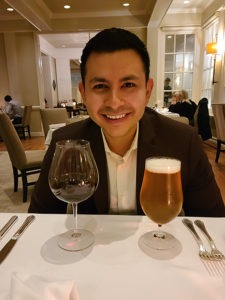When Manuel Gonzalez walks up to your table at the iconic Treadwell Cuisine in Niagara-on-the-Lake, you can be forgiven if you initially mistake him for the busboy, since he looks like he’s 16.
“I do get carded most of the time, especially if I haven’t shaved,” laughs the 30-year-old Canadian Association of Professional Sommeliers- and Court of Master Sommeliers-certified head somm at Treadwell, home to a Wine Spectator Two Glass Best of Award of Excellence beverage program.
 In some respects it’s been a very productive pandemic break for Gonzalez, who has enjoyed a front row seat to the wondrous evolution of his two-year-old son Milo, while helping his wife Sarah launch an online fitness business. But even under strict protocols and limited seatings, Gonzalez is itching to get back in front of guests and staff on June 14, when restaurants are slated to reopen according to Ontario’s three-stage plan.
In some respects it’s been a very productive pandemic break for Gonzalez, who has enjoyed a front row seat to the wondrous evolution of his two-year-old son Milo, while helping his wife Sarah launch an online fitness business. But even under strict protocols and limited seatings, Gonzalez is itching to get back in front of guests and staff on June 14, when restaurants are slated to reopen according to Ontario’s three-stage plan.
“You don’t know how much you appreciate something until it’s gone,” he says.
But, for the native of Guadalajara, sometimes you also don’t appreciate how good things can potentially be until you leave.
TheLushLife: Your native Guadalajara isn’t exactly known for its wine culture.
MG: “But it is known for beer and tequila, so the beverage industry is still very big, and at family functions there was always a lot of Corona and tequila. But I was an athlete as a youngster—taekwondo—so I was never that interested in the world of wine and beverages.”
So when did that change?
“Beyond the fact that there was red and white, I didn’t know anything about wine until I got to college here in Canada. While we were dating, Sarah took a wine appreciation course at Brock University and took me on a couple of wine tours. That’s where the bug took hold. I think Southbrook Vineyards was the first time that I got to really appreciate what’s in the glass—to notice differences in smells and tastes and textures.”
Why did you leave Guadalajara?
“I was 16. It was my fifth straight year as part of the state team, and just before I was scheduled to go to the Mexican Nationals. My parents (Ricardo and Silvia) had had a conversation about it earlier that year. They said we had to leave. You hear about the violence and gangs every day. They’d also tried to buy a house once, but couldn’t get a mortgage from the bank because they were self-employed. They owned a graphics design studio and a taekwondo academy—they are both black belts—but they were working 12- to 16-hour days every day, and there was no reward for it.
“They said, ‘If you want to stay, we’ll stay.’ But I knew they wanted to leave. And I was also aware of the opportunities and employment and that the quality of life would be a lot better in Canada. I wanted to go the Pan Am Games, but this was more important.”

A 16-year-old Gonzalez (in blue) competes at the U.S. Open Taekwondo Championships.
Speaking of it being unsafe, did you ever get into fights before leaving, where you had to use those taekwondo skills?
“Unfortunately I did—a couple of times back in Mexico, and they really came in handy. Luckily I’ve never had to use them here in Canada.”
Where did the family move to?
“My parents sold pretty much everything they had. My dad and I moved first, while my mom and sister stayed to live with my grandmother. We basically just jumped on a plane. We had no place to stay and decided we would just figure it out once we got here.
“We asked a random person at the airport if they could give us a lift to anywhere. They dropped us off at Gore Park in downtown Hamilton at about 1:30 in the morning. We walked to the nearest hotel. We’d wake up and then pretty much walk the city to try to find answers the next two days. Then we moved to a cheaper hotel for a week.
“One day we stopped at a bank to get some money. Luckily the teller was a girl from Honduras. My dad said, ‘We’re new here. We don’t know what to do.’ She directed us to a person who owned a little grocery store in downtown Hamilton that sold Latin American products. She said, ‘Tell him I sent you and that you’re looking to stay.’ The gentleman there told us what to do, and we moved to a shelter and started all the immigration applications.
“My mom and sister came at that point. My dad got part-time jobs anywhere he could. Then my parents were the cleaning crew for a restaurant after it closed at night. Then Miriam and I got enrolled in school. We went to St. Thomas More in Hamilton and learned to speak English from zero.”
Wow! So what eventually led you into the food and beverage industry?
“It was really out of frustration and necessity. I’d gotten a Bachelor’s Degree in Health Science and Health Motion degree at Sheridan College, but after looking for job in that field for months, I had to pay some bills, so asked for a serving job at a restaurant. Like a lot of people, I ended up getting swallowed up by it, learned to love it, and then never left.”
Looking back at the increasing violence in sectors of Mexico, you must be glad you left.
“It’s sadly part of everyday life there—it’s normal for a stabbing or a shooting, this person killed, a building burning down because someone owed money. When we came here, we’d turn on the news…and nothing has happened. It was weird at first—like, ‘What’s going on here?’
“But after a while, you get used to not hearing about terrible things all the time. And we’d appreciate how bad it is back in Mexico, and how lucky we are to be here. But we still have family there, and can’t understand why things aren’t changing.”
Let’s talk about happier times. In 2018, you completed your Court of Master Sommelier exam, finishing with the highest grade overall in your class, thus earning the Walter Clore Scholarship. And you got to work at the acclaimed Quatrefoil Restaurant in Dundas.
“I had a placement at Quatrefoil while I was doing my Canadian Association of Professional Sommelier course, under the supervision of Jose Luis Fernandez, 2019 winner of Best Ontario Sommelier. It was such a great opportunity to work there.”
And now you work in Niagara at Treadwell, which provides you a lot of exposure to the wineries there. Which ones stand out as really having stepped up their game in recent years?
“Every time I’m talking to guests about what we do well in Ontario, I always talk about Pinot Noir and Chardonnay. And Hidden Bench and The Farm are two of the best in the region for those wines. And On Seven Estate Winery, and Tawse’s Quarry Road Chardonnay. We also have pretty much every Pinot from Domaine Queylus, as well as some of their back vintages.
It seems like the bigger Ontario red wines have also turned a corner in recent years.
Definitely. One good example is Icellars Vineyards’ Cabernet Sauvignon and their blends. You can see it from their vineyard management, their picking times, the oak treatments, etc. that they are very serious about their red wines. And you also have the appassimento guys making big, bold reds, like Big Head and Foreign Affair. I think through trial and error, our aging vines and global warming, the reds are getting better and better. And 2020 will go down as an amazing vintage.”
Do you have an a favourite Ontario red wine?
“I’d say I have a favourite Ontario red style—fresh Pinots and Gamays. Something like Hidden Bench 2014 Felseck Vineyard Pinot Noir, a 100% organically certified wine, is up there. The Malivoire Genova Vineyard Gamay is also delicious. And Malivoire’s Moira magnums of rosé were a big hit last summer!”
And your favourite whites?
“It might be the Pearl Morissette Cuvée Dix-Neuvième Chardonnay. It’s a mystery because it’s always so different, but always intriguing and delicious. I’m always excited to try every vintage they release.”
Mexican wines are underrated, and there aren’t many available in Ontario. But which ones would you love to have on the menu at Treadwell, if you could access them?
“Casa Madero has some superb wines—in particular the Chardonnay and the Gran Reserva 3V red blend. There’s also a winery in Valle de Guadalupe called Finca Carrodilla. They’re big believers in organic and sustainable practices in the vineyard and low-intervention winemaking. Their shiraz is outstanding.”
Speaking of Mexico, give me your top three tequilas.
Casa Dragones is my number one. Unfortunately, it’s not available at the LCBO—only private order. But it’s worth it. Clase Azul is my number two. And Don Julio Añejo and Don Julio 1942 are tied for third.”
How do the Treadwell clientele compare with guests at Quatrefoil?
At Treadwell, since it’s Niagara-on-the-Lake, it’s much more international. On any given day you’ll have a table from Spain, five tables from the States, some from Germany, others from Toronto. It goes on and on.
“People who come from other countries are looking to taste what Niagara has to offer, and we definitely have that covered at Treadwell. People from Toronto and Niagara, on the other hand, are looking for something not from Ontario. They’ve already tasted Niagara and know what we do here for the most part.”
So what do you suggest for locals that invariably surprises them?
“For somebody who comes in and says, ‘I’m willing to experiment a little bit,’ one of my go-to regions is Priorat, Spain—especially the Mas Martinet Bru, a blend Grenache, Syrah, Carignan, Merlot and Cabernet Sauvignon. It’s a big red with lots of complexity, but still elegant. The perfect pairing on our menu is our braised lamb shoulder.
“Everyone I introduce that wine to says, ‘Wow, where has this been my entire life?’”



Leave a Reply
Your email is safe with us.